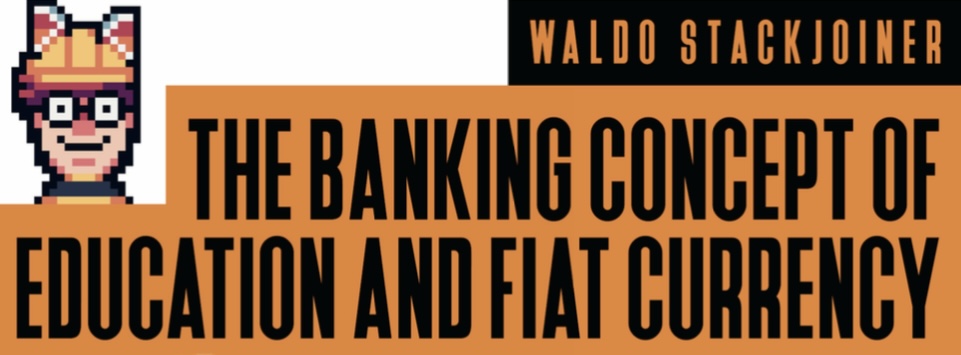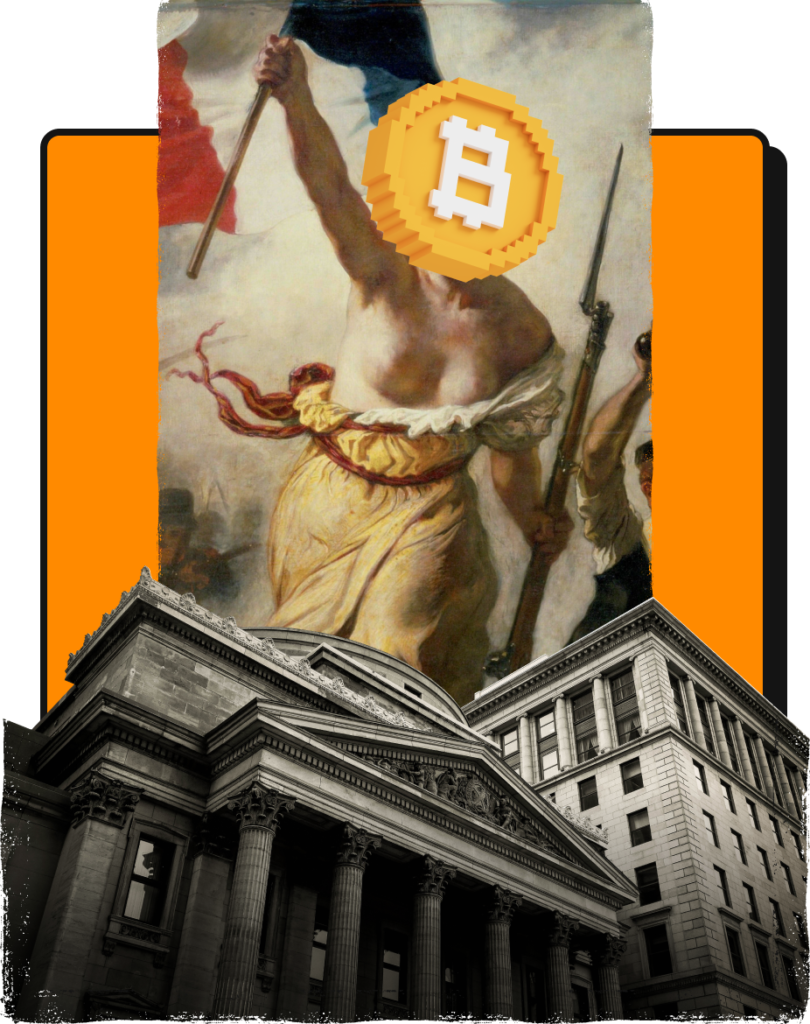
The Banking Concept of Education and Fiat Currency: Unveiling the Manipulation of Money
By Waldo Stackjoiner
@waldovision3
“Hegemony is a struggle in which the powerful win the consent of those who are oppressed, with the oppressed unknowingly participating in their own oppression.” ~McLaren
Introduction: In Paulo Freire’s influential work “Pedagogy of the Oppressed,” he breaks down the oppressive nature of the “banking concept of education”. The banking concept of education is a pedagogical approach that treats students like zombies, meek passive receptacles of information. The approach inevitably inhibits the students’ critical thinking and creativity. Drawing inspiration from Freire’s ideas, this article aims to explore the parallels between the banking concept of education and the use of fiat currencies, particularly the USD. Additionally, I compare the liberating potential of an alternative concept known as “problem-posing education” — “where people develop their power to perceive critically the way they exist in the world with which and in which they find themselves.” I apply this to the journey down the Bitcoin rabbit hole, where individuals discover the truth about money, its manipulation, and its impact on society and on their lives.
Quote 1 from Freire’s “Pedagogy of the Oppressed”:

Analysis 1 – Conformance and Obedience: The banking concept of education, similar to the use of fiat currencies like the USD, turns people into automatonic pools of approved data, oblivious to their condition as well as to a world where truth is only dictated from above. It prioritizes passive acceptance and memorization rather than fostering critical thinking and understanding. The teacher is the ultimate authority, attempting to back up this role with sonorous language. Similarly, this approach perpetuates a system where individuals are expected to unquestioningly accept and use the currency without fully comprehending its underlying mechanisms. Just as the banking concept inhibits the transformative power of education, fiat currencies hinder economic transparency and autonomy, leading to issues such as inflation and increasing wealth inequality without most citizens knowing that the manipulation of money itself is what causes them. Instead, they believe the resounding words of those in power which in reality only fuel the goal of division.
Quote 2: “Any situation in which some individuals prevent others from engaging in the process of inquiry is one of violence.”
Analysis 2 – Fiat Currency and the Suppression of Inquiry: Imagine a system where only a select group of people know how to read. The rest of society has to take their words at face value because they cannot verify the truth for themselves. This is the structure the banking concept of education and fiat currencies employ to manipulate people into remaining financially illiterate and incapable of critically reasoning out why. They both perpetuate a system where certain individuals and institutions hold the power to control and manipulate the flow of information and resources. In this context, the suppression of inquiry is a form of violence; while violence is typically associated with physical harm, the suppression of inquiry can be equally damaging on an intellectual and emotional level.
In this system, anything that counters the mainstream narrative is automatically labeled “misinformation”, regardless of its merits. Likewise, by limiting individuals’ access to knowledge about the true nature of money and its impact on society, the existing power structures maintain their dominance. Fiat currencies, being controlled by centralized authorities, can be subject to manipulation and arbitrary decisions that disproportionately affect those furthest away from this control (i.e., the Cantillon effect). Questioning this system is met with suppression tactics, claims on authority via regimes of truth, which limit dialogue and reinforce the status quo. As a result, individuals may feel oppressed, powerless, and marginalized, similar to how victims of violence may experience a loss of agency and autonomy.

Quote 3: “The teacher presents himself to his students as their necessary opposite; by considering their ignorance absolute, he justifies his own existence.”
Analysis 3 – Rule by Decree: In the banking concept of education, the teacher assumes an authoritative role, perpetuating the students’ perceived ignorance. Parallels to this teacher can be drawn to news anchors, lobbyists, and politicians, with regular working folks distracted and propagandized into ignorance and thus submission. For example, how many people still think the USD is backed by gold? How many people believe inflation is caused by Russia, by “greedy” corporations all coordinating price hikes together, or by workers themselves?
In contrast, problem-posing education, similar to the exploration of the Bitcoin rabbit hole, nurtures transformative learning experiences, peeling back the layers of reality for all to witness. Likewise, venturing into the world of Bitcoin prompts individuals to question the authority that sustains its own existence and seeks a deeper comprehension of how money functions, as well as how it affects everything it touches. Whereas fiat currencies rule by decree, discovering Bitcoin opens up the conversation to how money, and thus the systems built around it and with it, could be otherwise — perhaps even better for humanity at large. This path, however, is up to the individuals to use, improve and build on if they wish to free themselves of the ‘absolute ignorance’ depicted.
Quote 4: “Problem-posing education, as a humanist and liberating praxis, posits as fundamental that the people subjected to domination must fight for their emancipation.”

Analysis 4 – Problem-Posing Education and the Bitcoin Rabbit Hole: Problem-posing education and the exploration of Bitcoin share a common aspiration for freedom. Problem-posing education spurs individuals to challenge oppressive structures, fostering critical consciousness. Likewise, delving into the world of Bitcoin enables them to recognize the shortcomings of traditional financial systems and advocate for a decentralized alternative, where no human(s) is in charge of their financial fate. For example, with Bitcoin’s hard-cap of 21 million coins, workers can use it as a savings tool over the long-term, thereby safeguarding the value of their savings against the erosive effects of inflation. Further, Bitcoin is open access, offering anyone from anywhere the same opportunity to save (and spend) based on the same exact set of rules (math + code). Embracing Bitcoin empowers individuals as active participants in reshaping their own lives without permission from anyone. Bitcoin offers the potential to forge a more just financial landscape, where people wield predominant control over their financial transactions, free from the limits and biases of traditional financial systems that disproportionately harm those with limited or no access to them. Finally, there is a tool that everyone can use to free themselves from the external constraints that confine them.
Quote 5: “The greatest humanistic and historical task of the oppressed: to liberate themselves and their oppressors as well.”
Analysis 5 – Bitcoin as a Path to Liberation: Just as problem-posing education empowers the oppressed, the study of Bitcoin and its underlying technology empowers individuals to challenge the existing financial order. Through education and action, individuals can embark on a journey to liberate themselves from fiat currency control and manipulation.. In this process of liberation over the coming decades, it becomes evident that the oppressors, too, can be liberated from the corrupted system they uphold. Compassion and humanity remind us that all individuals, oppressors included, are prisoners of the very system they have helped create. An “us versus them” dichotomy is an illusion that only exists by feeding it more attention. By liberating the oppressors from their own oppressive actions, one can open the door to collective healing and transformation, fostering kindness and fairness over the exploitation and inequality that has fueled the fiat regime. Bitcoin is, in fact, good for everyone. As we strive for financial sovereignty and autonomy, each of us can choose to extend our vision of liberation from the fiat chains to include everyone, leading by truth and reconciliation instead of anger and hatred. Indeed, Bitcoin can forever remain “a peaceful revolution.”
Conclusion: In the words of a well-known cartoon squirrel in defining “fiat fuckery”, “It’s just deeply unfair, it’s unjust, it’s an extremely complex and convoluted form of theft that relies on its complexity to go largely unnoticed” (Allen Farrington). By drawing on the framework of Freire’s “Pedagogy of the Oppressed,” we can shed light on the parallels between the banking concept of education and the use of fiat currencies. Both perpetuate structures of oppression by limiting individuals’ understanding and agency. However, the concept of problem-posing education and the journey into the world of Bitcoin offer a path towards liberation. These transformative experiences empower individuals to question, challenge, and reimagine the prevailing systems of control, ultimately creating a path to a more just and inclusive future.
______________
Note from Stackchain Magazine: No Bitcoin (or inferior monies) were exchanged for this article. Also now we know why we’ve spent so much time looking for Waldo. That motherfucker is smart! If you’d like to see more Waldo please consider sending him a tip at richestrod82@livingroomofsatoshi.com or you can follow him on X @WaldoVision3




